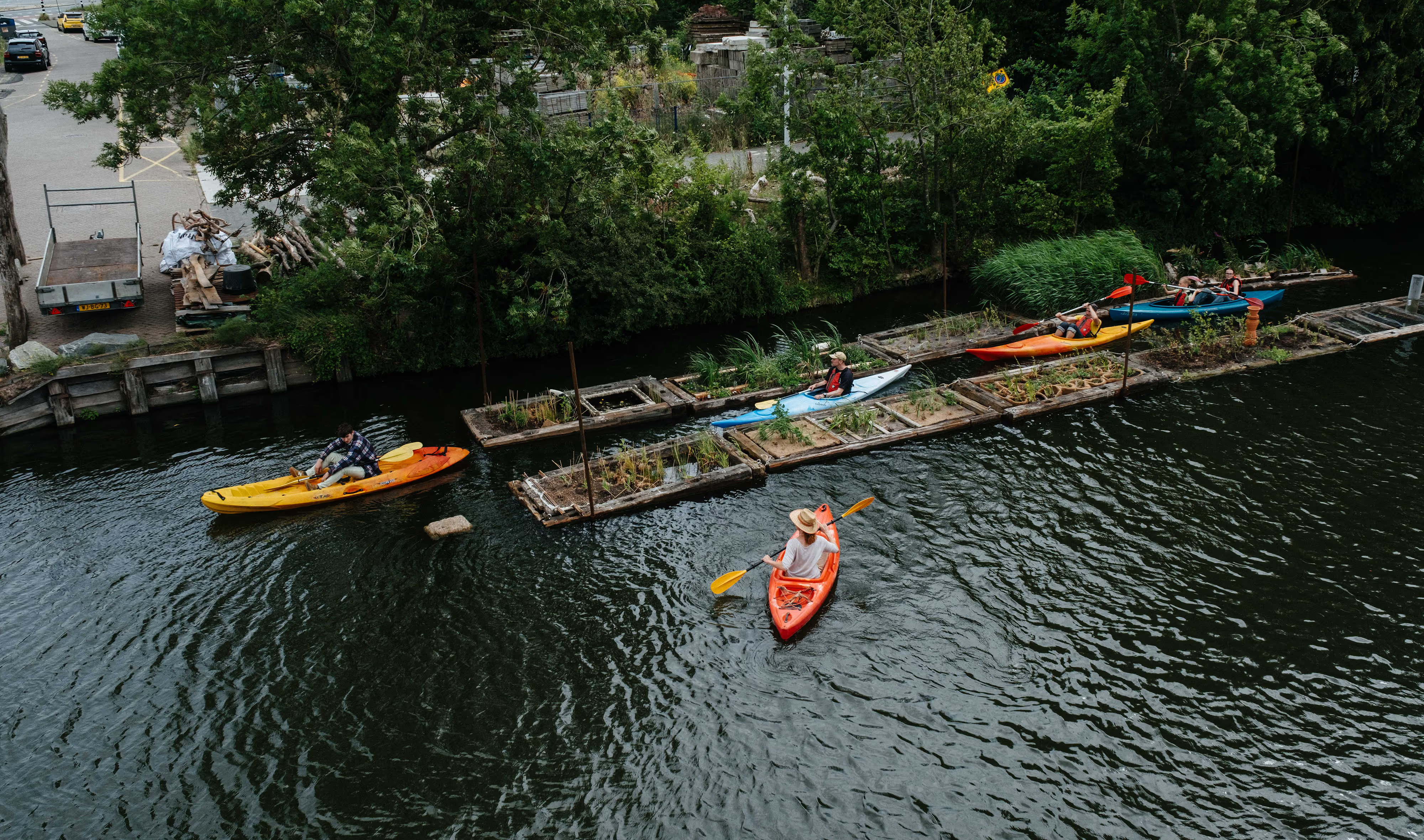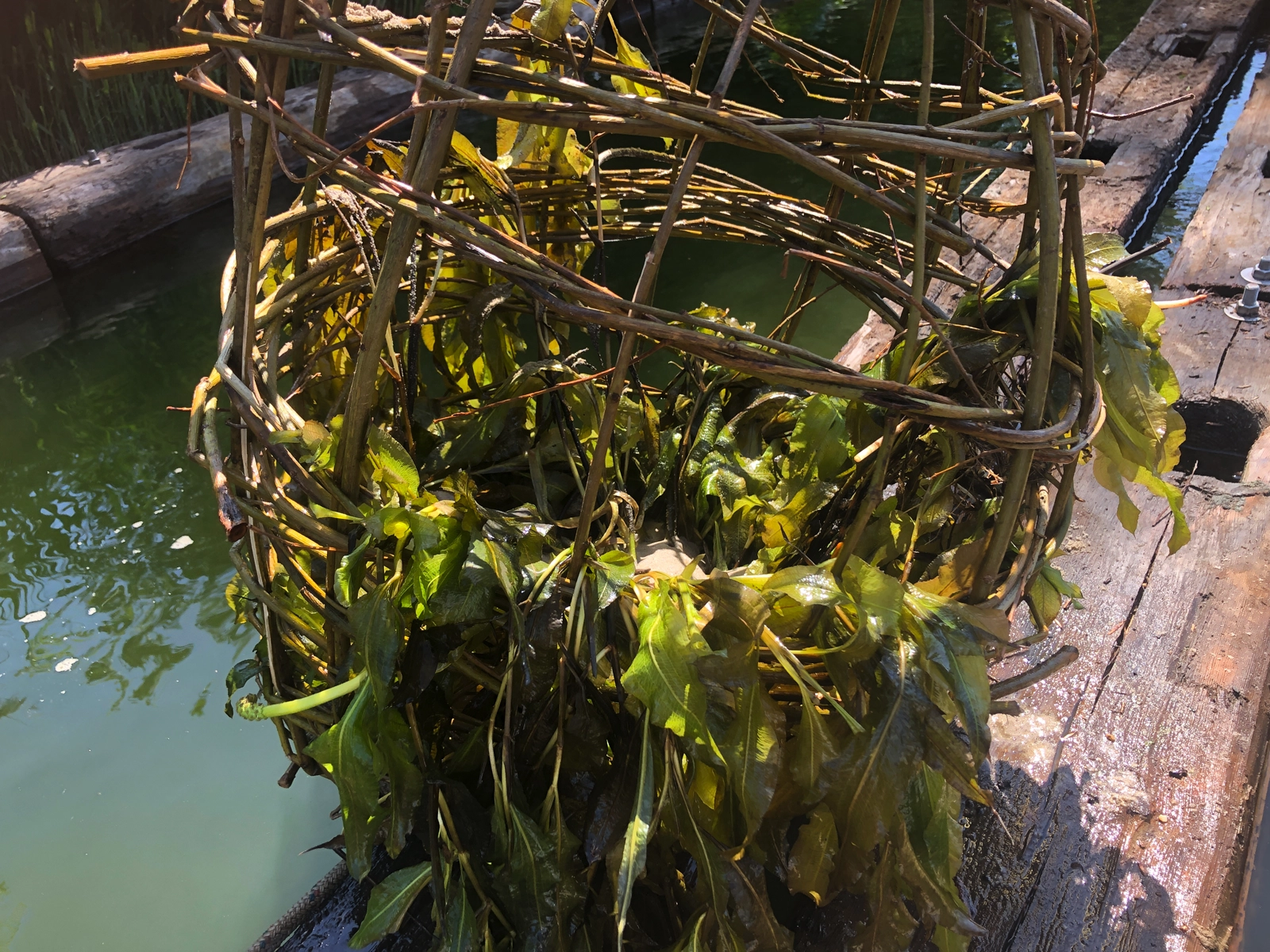
In many waterways, nature has little chance to thrive
due to hard quays, wind, and currents.
These Waterkaravaan gardens provide structure, shelter, and places of recovery.
Various planted, porous matrices create space for micro-life and riparian nature.
Made with local, reused compostable materials
and built ánd maintained by a sheltered workshop.

Photo Waterkaravaan with canoeists: Coen Dijkstra
How do you create sufficient leeway against currents, waves and wind? How do you create structure, a three-dimensional matrix that provides support to plant roots and (micro) organisms? How to start a food chain? In short: How do you create a robust floating biotope in the city?

Native (local) plants are used that fit here, and that are also host plants for local insects and animals. Many different shore and aquatic plants have been planted, and it remains to be seen which plants are doing better or less well. Aquatic plant growers are closely involved in this project. The project contains proven concepts but also experiments. Especially when the plants thrive underwater, we are particularly satisfied. After all, they are having quite a tough time in the city, and it is quite a challenge.
Plants were adopted after the waterway inspection (when they clear the ditches in the autumn), plants were grown locally for this project, and plants were purchased from growers. An important requirement is that they can withstand Amsterdam's moderately brackish water, which is in open connection with the North Sea Canal.

All gardens comply with the Programme of Requirements and Preferences, which was used as a guideline for choices in the overall design and the selection of collaborating partners with their own garden modules, plants and materials. In practice, discoveries are constantly being made that lead to new design insights, the so-called design feedback loop. Sometimes things go wrong, but that is part of pioneering.
Design requirements include, for example: no shadow nuisance for existing or potential soil nature, no toxic substances or plastic pollution, only building materials that compost under natural conditions with the exception of stainless steel fasteners, and only native and brackish water-tolerant plants.
Design preferences include, for example, that the matrices (three-dimensional structures) create optimal sheltered areas for aquatic life, that the structures, plants and all the life they attract have an optimal effect on water quality and biodiversity in and around the water, and that means also that as many plants as possible have their roots hanging in the water. Another requirement is that the materials used are sourced and/or reused as locally as possible. It is also important that the gardens require little maintenance and that maintenance can be used to control the diversity of species and the purifying effect of the gardens.

How do you make a floating garden if you don't want to use plastic or styrofoam? How do you ensure sufficient buoyancy even when the plants are getting heavier? Which local materials are suitable for this, and can you also use residual materials? Which parts should last a long time and which parts are allowed to compost more quickly under natural conditions?
The starting point here is that the shell and the connections last a very long time, but that some initial structures may perish: root packages from the plants themselves partly take over. This way, you can use more local and natural materials.
The renovation of quays and bridges in Amsterdam has released 160-250-year-old European softwood, which is being used in this project as a floating base for gardens. The robust frames also make the gardens transportable by water.
Many of Amsterdam's quays were built around 1880. European softwood was used for the piles, braces and planks. This wood comes from seedlings that were planted around 1800. In 225 years, the tree has transformed from seed to tree, and from quay construction to floating garden.
This project is, of course, ongoing. We like to create new gardens to enhance the aquatic environment. We can tailor these gardens to a specific locations and functionalities. The gardens will also continue to evolve based on the results of monitoring and (design) research. This will also demonstrate the added value for biodiversity and water quality.